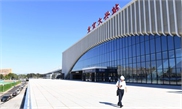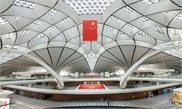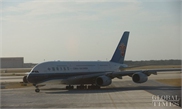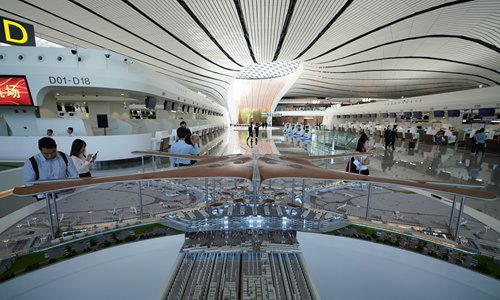
A scale model of the Beijing Daxing International Airport sits inside the airport on Wednesday. The new international airport is located 46 kilometers south of downtown Beijing. The new aviation hub is shaped like a phoenix spreading its wings. Photo: Xinhua
President Xi Jinping on Wednesday inaugurated a state-of-art airport in Beijing, marking a monumental moment that highlighted both the country's prowess in building massive infrastructure and its ambition to further connect the world in keeping with its rising global status.
With flights departing for different domestic destinations on Wednesday afternoon, the Beijing Daxing International Airport, whose elegant design, advanced technologies and massive capacity have already gained global attention, officially began operating.
Xi stressed that the new airport can complete its scheduled construction tasks in less than five years and start operating smoothly, fully demonstrating the strength of China's engineering.
"I feel honored to navigate a plane today as the moment is of great significance just before the 70th anniversary of the founding of the People's Republic of China," said Li Daxing, captain of the first flight of Capital Airlines departing from the new airport.
China Southern Airlines' A380 became the first flight taking off from the new airport at 4:22 pm to Guangzhou, capital of South China's Guangdong Province. This was followed by other carriers, including China Eastern Airlines, Air China, China United Airlines, Capital Airlines, Hebei Airlines and Xiamen Air, which began their respective operations.
"The appearance of the terminal building is like a phoenix, which means Daxing airport aims to soar to great heights," Li added, noting that the new airport aims to reach the top in terms of passenger flow (more than 100 million) in the next 10 years.
The airport was constructed at a cost of 80 billion yuan ($11.2 billion).
The airport, which has four runways, parking space for 150 airplanes and a 700,000-square-meter terminal building, is expected to handle 45 million passengers by 2021, and 72 million by 2025.
By comparison, the busiest airport in the world, Hartsfield-Jackson Atlanta International Airport, handled 107 million passengers in 2018.
The successful launch of the new airport represents the formation of the "two cities and three airports of tens of millions of passenger flow" pattern in Beijing and North China's Tianjin Municipality - the first such pattern in the history of China's civil aviation industry, authorities of the new airport said.
"I feel happy and proud to catch a flight from the new airport, which features high technology and can be regarded as one of the first-class airports in the world," said a passenger named Wang Guoxing, who boarded a Capital Airlines flight to Hangzhou, East China's Zhejiang Province together with his wife and grandson.
"The new airport reflects the rapid growth of China's economy and highlights domestic infrastructure. It is also a gift ahead of China's 70th founding anniversary celebrations," Wang told the Global Times.
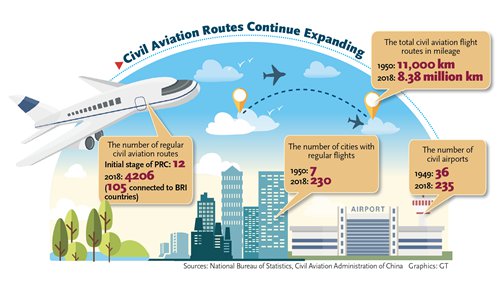
Graphics: GT
Further growth
The family of Zha Yan, a 27-year-old employee at the Longnan Chengxian Airport in Northwest China's Gansu Province, witnessed the growth of China's civil aviation industry.
"During my grandfather's time, the newly established domestic civil aviation industry had difficulty advancing," Zha told CAAC Inflight Magazine, noting that there was no full-time navigation dispatch, and the takeoff and landing of flights were done by the station master himself.
From the 1950s, Gansu Province developed its flight team, maintenance group, navigation, weather report and oil depot, Zha said, citing her grandfather's story.
Her comment is also another footprint for the development of fleet size for the tower controller.
Zhang Jing, head of the tower controller department of the Daxing Air Traffic Control Center, began as a controller in 2003.
In 2003, the daily fleet size they controlled at the Beijing Capital International Airport was 700 a day. But now, it has jumped to about 1,800 daily, and it is believed that the number could breach 2,000 after the new airport starts operating, he told the Global Times on Wednesday.
He said in the past, the peak hours in the morning was only from 8 to 9 am, but now, it could be from 6 to 10 am. In the evening, the peak season in the past was normally from 7 to 9 pm, but now will last until 2 am.
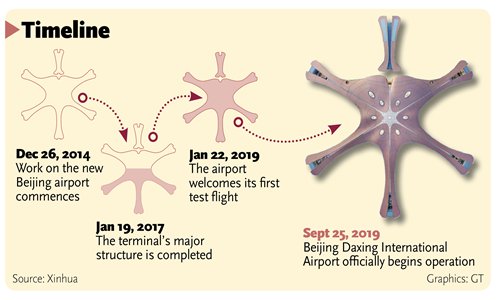
Graphics: GT
New drive
The number of regular civil aviation routes was 12 during the initial stage of the People's Republic of China and rose to 4,945 in 2018, according to data from the National Bureau of Statistics.
Civil aviation routes in terms of mileage increased from 11,000 kilometers in 1950 to 8.38 million kilometers in 2018. The number of civil aviation airports increased from 36 in 1949 to 233 in 2018.
The new airport will also drive passenger flow, goods, capital and information and facilitate the integration development of China's Jingjinji (Beijing-Tianjin-Hebei) area, experts noted.
The Daxing airport is a new engine for economic growth in China, said Yan Xiaodong, spokesman for the North China regional administration of the Civil Aviation Administration of China.
Yan said the new airport sets a standard for other areas in the country, and with an increase in flights from other areas, they will absorb experience from North China and will further develop.
The new airport will help promote the upgrade in China's air network as it will more conveniently connect China with Japan, South Korea and other Northeast Asian countries, experts said.
As Chinese cities, major and smaller ones, have realized the importance of airports to the growth of their local economy, they have begun constructing or expanding their airports, Qi Qi, an independent industry analyst, told the Global Times.
By the end of 2018, China has 235 civil airports, including 37 with at least 10 million passengers annually. Among these, 10 were at the 30 million level.
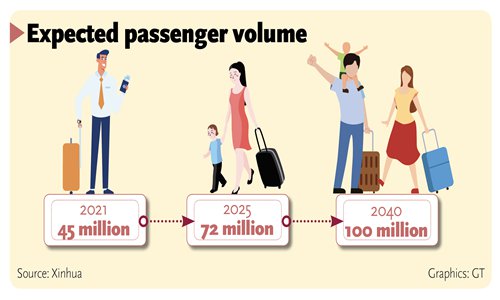
Graphics: GT
Positioned as one of the vital global hubs, the Daxing airport will not only serve domestic markets, but will play a bigger role in handling global routes, Qi said.
There are 66 airline companies, 20 from Chinese mainland and 46 from Hong Kong and Macao special administrative regions, the island of Taiwan as well as foreign countries, willing to station at the Daxing airport after flights commence. A total of 116 air routes will be opened, including 101 domestic and 15 global routes.
China Eastern Airlines said it will put 200 medium and large aircraft into operation at the new airport, connecting the Americas, Europe, Oceania, Southeast Asia, Japan and South Korea, as well as China's Hong Kong, Macao and Taiwan to the mainland.
As the Chinese aviation industry eyes internationalization, major airlines are trying to expand their presence in the global air network, in Belt and Road Initiative (BRI) markets in particular, Qi noted.
So far, China Southern Airlines has launched 172 routes from 38 countries and regions along the BRI, handling more than 15 million trips each year.

